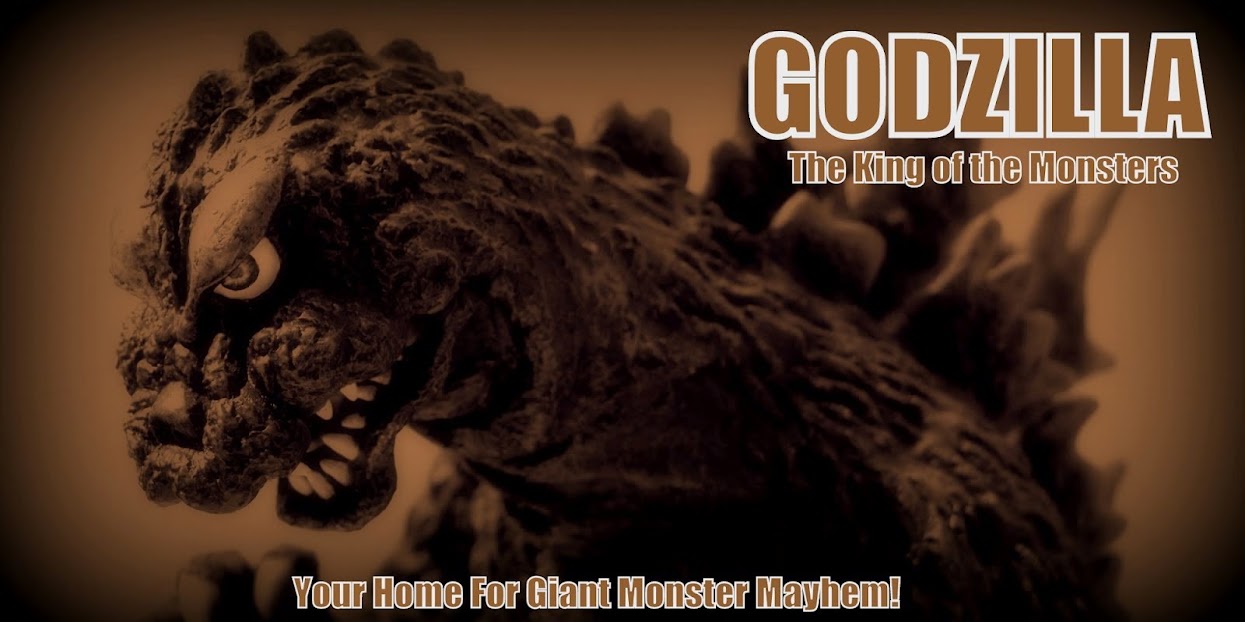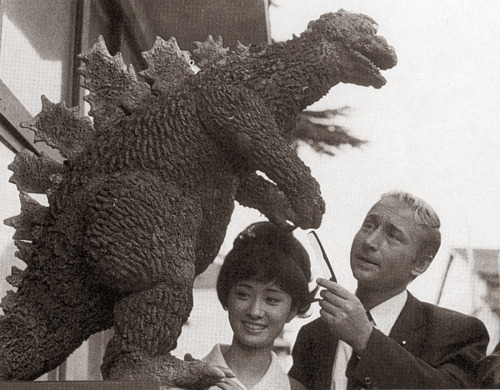 Above, Armand with the Godzilla statue in Hibiya. Photo courtesy of Richard Pusateri.
Above, Armand with the Godzilla statue in Hibiya. Photo courtesy of Richard Pusateri.Ten years ago this coming Halloween (October 31), I arrived at the United Airlines Los Angeles International Airport (LAX) terminal for my first trip to Japan. Up to that point, my only "foreign" travels consisted of automotive crossings of the Canadian and Mexican borders from the United States.
October 31 of 2001 was an uneasy time. The September 11 terrorist attacks on the World Trade Center in New York and the Pentagon in Washington, D.C. were still fresh in peoples' minds. The National Guard posted armed (some say the rifles weren't loaded) guardsmen in airport terminals around the country. LAX was no exception. Security was (and still is) extremely tight at airports.
 Above, Richard and Armand with Haruo Nakajima at the Tokyo International Film Festival. Photo courtesy of Richard Pusateri.
Above, Richard and Armand with Haruo Nakajima at the Tokyo International Film Festival. Photo courtesy of Richard Pusateri.But, I wasn't about to let this heightened security stop me from making my first overseas visit to another country, even though my mother really didn't want me to go. As Japan is 17 hours ahead of Los Angeles time, I arrived at Narita Airport on November 1 (the International Dateline is crossed in the mid-Pacific).
The year before, fellow G-fan Richard Pusateri took a trip to Japan to see Godzilla x Megaguirus. After hearing his tales of adventure and grand time he had upon his return, I got the urge to go to Japan myself. Luckily, I was working as a temp at a Farmers Insurance claims office and security patrol at the time, so I was able to afford a Japan trip. All I had to do was to get a U.S. Passport, plane ticket and hotel reservations. In rapid order, all were obtained.

The 2001 Tokyo International Film Festival was featuring the premiere of Godzilla, Mothra and King Ghidorah: Giant Monsters All-out Attack on November 3. So, I decided to time my visit for that. As it happened, Richard was also planning to attend and we met several times at Chili My Soul in Encino to plan the trip. At least I would know somebody while there (other familiar names and faces were also there, it turned out).
Since I was writing for G-FAN at the time, I was also able to obtain a press pass for the Godzilla screening. This allowed me access to the stage for the pre-movie festivities (below).

Following the movie, Richard and I rubbed shoulders with Haruo Nakajima, Hideyo Amamoto, Shogo Tomiyama and others.
 Above, Godzilla prop at Toho Studios. Mothra rests nearby on a shelf. Photo courtesy of Richard Pusateri.
Above, Godzilla prop at Toho Studios. Mothra rests nearby on a shelf. Photo courtesy of Richard Pusateri.I was invited to take a V.I.P. tour at Toho Studios while in Japan and was able to invite Richard along. Fortunately, 2001 wasn't 2005, when Toho began demolishing the big pool and several of their old sound stages and facilities, so we were able to see the studio as it was when Eiji Tsuburaya and Ishiro Honda were making movies. One of the things we were greatly impressed with was Toho's old snack bar. It was like stepping back 40+ years in time. Unfortunately, the snack bar is now history. We were shown the studio by Executive Producer Shogo Tomiyama, spfx director Koichi Kawakita and Shozo Watanabe of Toho International following lunch in Hibiya.
For my first visit to Japan, I decided to stay at a ryokan (Japanese inn) to see what it would be like. It was an enjoyable experience (plus the room was cheaper in price). The ryokan was the Hotel Fukudaya in the Shibuya ward of Tokyo. The Tokyo International Film Festival would be screening the Godzilla movie at Orchard Hall in the Bunkamura in Shibuya, within walking distance.
 Above, Godzilla entertains attendees of the film festival. Photo by Armand Vaquer.
Above, Godzilla entertains attendees of the film festival. Photo by Armand Vaquer.The Hotel Fukudaya was also a couple of blocks away from a Denny's Restaurant (it was a surprise seeing Denny's in Japan). While I like Japanese food, I prefer to have a western-style breakfast. Denny's came in handy for that.
 Above, Atami, Japan. Photo by Armand Vaquer.
Above, Atami, Japan. Photo by Armand Vaquer.My wanderings in Tokyo on that first trip included Ginza, Hibiya, the Imperial Palace, Tokyo Tower, the National Diet Building, Harajuku, Zojo-ji Temple, Shibuya, Shinjuku and Nakano (where I bought a few things from the Mandarake store). Outside of Tokyo, I visited Atami and some areas near Mt. Fuji. After all, I just had to include some Shinkansen (bullet train) traveling experience on the trip!
I also visited the HMV video and record store in Shibuya to see the Godzilla and Baragon filming suits from GMK on display.
One thing that was not planned was a 24-hour flu bug I caught. Thank goodness it only affected roughtly one day of the trip. Since then, I make sure I take Vitamin C tablets every day for about two weeks before a trip and continue taking them during the trip. (I have been back to Japan five more times and have not gotten sick since I started the Vitamin C regimen. This is a word to the wise!)
 Above, with Shogo Tomiyama (far left) and Koichi Kawakita (far right) at Toho Studios. Photo courtesy of Richard Pusateri.
Above, with Shogo Tomiyama (far left) and Koichi Kawakita (far right) at Toho Studios. Photo courtesy of Richard Pusateri.Besides the jaunts around Tokyo, Mt. Fuji and Atami, I attended an after-premiere dinner party at a Chinese restaurant in Nakano that included Kenpachiro Satsuma and Hiroko Sakurai. It was interesting riding shotgun in a taxi on a rainy night as the driver zig-zagged through traffic (Japanese cars have the driver on the right, just as in England) on Tokyo's side streets to get to the dinner party.
 Above, the Nijubashi Bridge at the Imperial Palace in Tokyo. Photo by Armand Vaquer.
Above, the Nijubashi Bridge at the Imperial Palace in Tokyo. Photo by Armand Vaquer.This was the trip that started me on the kaiju location article series for G-FAN and, eventually, The Monster Movie Fan's Guide To Japan.
For me, it was a memorable trip and a highly enjoyable one. I decided then that I would re-visit Japan as often as time (and the ol' wallet) will allow. It is hard to believe that ten years has already passed since this trip. The next time I traveled to Japan was with the first G-TOUR in August 2004. I've returned there four more times (2005, 2006, 2007 and 2010).


